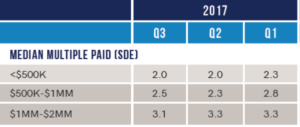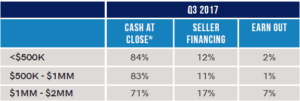The Value of a Sell-Side M&A Advisor to Buyers
 Strategic and financial buyers often tell me how they appreciate the value that experienced, ethical and professional sell-side M&A advisors (a.k.a. business intermediaries, investment bankers, or business brokers) bring to a deal; even when that advisor represents the seller!
Strategic and financial buyers often tell me how they appreciate the value that experienced, ethical and professional sell-side M&A advisors (a.k.a. business intermediaries, investment bankers, or business brokers) bring to a deal; even when that advisor represents the seller!
As a buyer, you can expect a sell-side M&A advisor to help by compiling, analyzing and serving up relevant business information, by bringing transparency to the process, by facilitating the process, by introducing funding sources and other resources, by anticipating and solving problems, and by being an unemotional conduit between you and the seller. The advisor will have an effective and transparent process for selling the business, and you will understand what that process is.
When you acquire a business through an experienced professional sell-side M&A advisor, here is how you benefit at each stage of the process:
- Confidentiality — Maintaining confidentiality is in your best interest as a potential owner, and the advisor’s sale process is designed to protect sensitive information. It starts with the advisor supplying an NDA on reasonable/market terms that is normally ready to sign.
- Screening — A good advisor will ask about your acquisition criteria and funding plans, and communicate the seller’s needs and expectations. They will make their own assessment of fit and confirm both parties’ commitment to moving forward in the process. When they don’t think the fit is right, they will tell you to avoid wasting everyone’s time.
- Discovery — You will receive a Confidential Information Memorandum (CIM)* with a detailed narrative and important facts and figures on the target company. The M&A advisor wants you to be able to make an informed and dependable decision; and therefore strives for accuracy, transparency and balance in the information presented. After you absorb the CIM, the intermediary will have answers to many of your follow up questions.
- Management Meeting — A seasoned intermediary makes site visits and management meetings more productive by establishing desired outcomes for the parties, co-developing an agenda, helping the seller prepare, facilitating important conversations, and following up post-event.
- LOI Negotiation — Based on my experience and feedback from transaction attorneys, letters of intent that are negotiated with the involvement of a seasoned M&A advisor tend to be clearer on economic deal points and stronger with respect to contingencies, process and time frames. They result in less renegotiation and are more likely to close.
- Due Diligence — The intermediary will set up and maintain a data room and help everyone organize, schedule and facilitate this phase; which saves you time and aggravation.
- Financing — The advisor can liaise with (and introduce) debt and equity capital providers. They can compile and summarize information for the application process. Their knowledge of what these parties need, and what they will and won’t do, helps them anticipate and resolve issues that arise and save you valuable time.
- Closing — A good M&A advisor works closely with the parties, their attorneys and CPA’s and other specialists throughout the acquisition process. They have great project management skills and attend to numerous details, anticipate and resolve roadblocks, and quarterback various activities to keep the process moving to a successful and timely closing, which is in everyone’s interest.
The bottom line is that professional and experienced sell-side M&A advisors save buyers time, effort and transaction costs, and increase the likelihood of getting from LOI to the closing table. Of course they will also make sure you pay a fair price.
* A CIM analyzes a company’s financial statements and covers its history, customers and markets, operations, personnel, facilities, key contracts, fixed assets, intangible assets, strategic relationships, competition, industry dynamics, growth opportunities, projections, and more.
For further information on the services of an M&A advisor on the sell-side or buy-side, contact Al Statz at 707-781-8580 or alstatz@exitstrategiesgroup.com.




 SBA 7(a) loans are a popular type of financing for small business acquisitions. These loans go up to $5,000,000 and can be used to buy a business, real estate or equipment. Several changes to the SBA 7(a) program became effective in 2018 that are worth noting.
SBA 7(a) loans are a popular type of financing for small business acquisitions. These loans go up to $5,000,000 and can be used to buy a business, real estate or equipment. Several changes to the SBA 7(a) program became effective in 2018 that are worth noting.


 A simple five step plan that can help you target and invest in a business:
A simple five step plan that can help you target and invest in a business:

